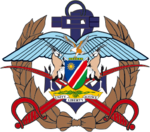| Namibian Defence Force | |
|---|---|
 NDF Tri-Service Emblem | |
 NDF Tri-Service Flag | |
| Founded | 2 June 1990 |
| Service branches | |
| Headquarters | Windhoek, Khomas Region, Namibia |
| Website | www.mod.gov.na/ndf |
| Leadership | |
| Commander-In-Chief | Nangolo Mbumba |
| Minister of Defence | Frans Kapofi |
| Chief of the Defence Force | Air Marshal Martin Pinehas[1] |
| Personnel | |
| Military age | 18–25 years |
| Conscription | No |
| Active personnel | c. 13,000 |
| Expenditure | |
| Budget | N$7.2 billion (2015)(US$465 million)[2] |
| Percent of GDP | 3.0% (2020 estimate)[2][3][4] |
| Industry | |
| Domestic suppliers | August 26 Holding |
| Foreign suppliers | |
| Related articles | |
| History | Caprivi Conflict Second Congo War |
| Ranks | Military ranks of Namibia |
The Namibian Defence Force (NDF) comprises the national military forces of Namibia. It was created when the country, then known as South West Africa, gained independence from apartheid South Africa in 1990. Chapter 15 of the Constitution of Namibia establishes the NDF and defines its role and purpose as, " ... to defend the territory and national interests of Namibia".
Namibia's military was born from the integration of the formerly belligerent People's Liberation Army of Namibia (PLAN), military wing of the South West African People's Organization, and the South West African Territorial Force (SWATF) – a security arm of the former South African administration. The British formulated the force integration plan and began training the NDF, which consists of five battalions and a small headquarters element.[7] The United Nations Transitional Assistance Group (UNTAG)'s Kenyan infantry battalion remained in Namibia for three months after independence to assist in training the NDF and stabilize the north. Martin Shalli and Charles 'Ho Chi Minh' Namoloh were involved in the negotiations that allowed the Kenyan infantry battalion to remain for that period.
- ^ Muraranganda, Elvis (3 January 2014). "'Top Three' absent at Mutwa's NDF inauguration". Namibian Sun. p. 1. Archived from the original on 3 January 2014. Retrieved 3 January 2014.
- ^ a b Insight 2015, p.33
- ^ defenceWeb (16 April 2015). "Further spending for Namibian military". defenceweb.co.za. Archived from the original on 8 December 2015. Retrieved 13 October 2015.
- ^ "Namibia Economy Profile 2018". Archived from the original on 24 September 2015. Retrieved 13 October 2015.
- ^ a b c d e f g h "Trade Registers". Archived from the original on 14 April 2010. Retrieved 19 June 2013.
- ^ a b "Scramble for the Congo – Anatomy of an Ugly War" (PDF). ICG Africa. 20 December 2000. Archived from the original (PDF) on 29 October 2013. Retrieved 18 June 2013.
- ^ http://www.satruth.co.za/peace.htm Archived 25 May 2009 at the Wayback Machine. Retrieved June 2009